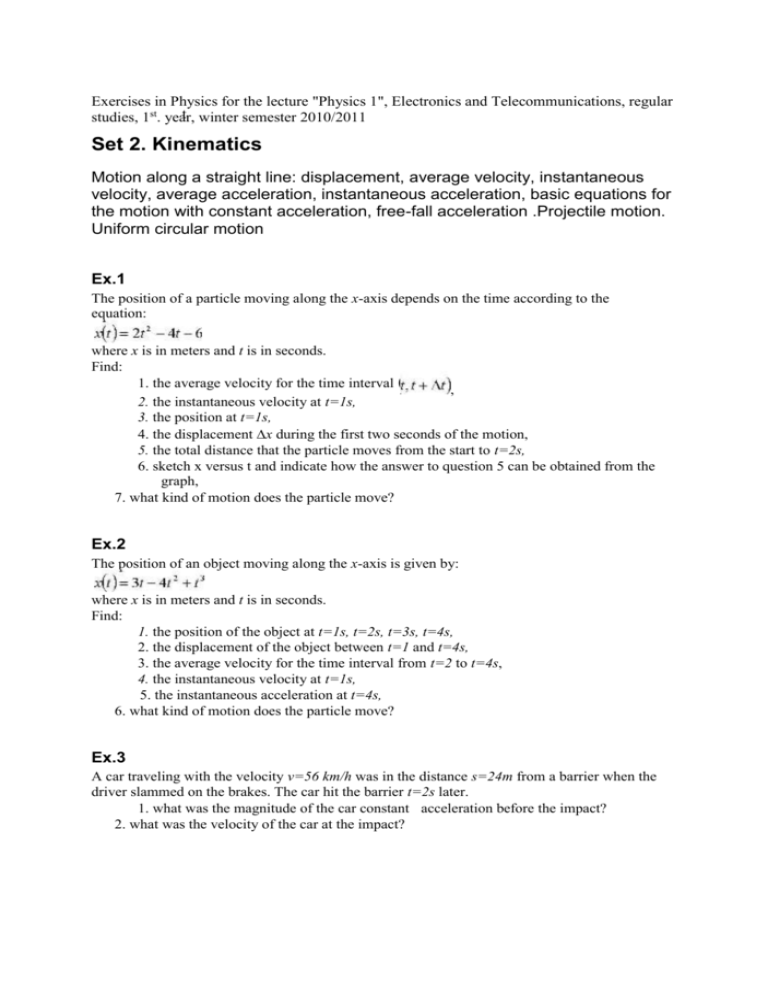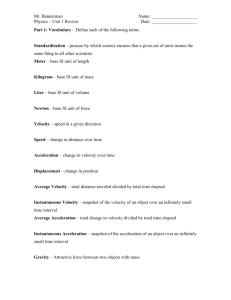Set 1
advertisement

Exercises in Physics for the lecture "Physics 1", Electronics and Telecommunications, regular t winter semester 2010/2011 studies, 1st. year, Set 2. Kinematics Motion along a straight line: displacement, average velocity, instantaneous velocity, average acceleration, instantaneous acceleration, basic equations for the motion with constant acceleration, free-fall acceleration .Projectile motion. Uniform circular motion Ex.1 The position of a particle moving along the x-axis depends on the time according to the equation: where x is in meters and t is in seconds. Find: 1. the average velocity for the time interval ( , 2. the instantaneous velocity at t=1s, 3. the position at t=1s, 4. the displacement ∆x during the first two seconds of the motion, 5. the total distance that the particle moves from the start to t=2s, 6. sketch x versus t and indicate how the answer to question 5 can be obtained from the graph, 7. what kind of motion does the particle move? Ex.2 The position of an object moving along the x-axis is given by: where x is in meters and t is in seconds. Find: 1. the position of the object at t=1s, t=2s, t=3s, t=4s, 2. the displacement of the object between t=1 and t=4s, 3. the average velocity for the time interval from t=2 to t=4s, 4. the instantaneous velocity at t=1s, 5. the instantaneous acceleration at t=4s, 6. what kind of motion does the particle move? Ex.3 A car traveling with the velocity v=56 km/h was in the distance s=24m from a barrier when the driver slammed on the brakes. The car hit the barrier t=2s later. 1. what was the magnitude of the car constant acceleration before the impact? 2. what was the velocity of the car at the impact? Ex.4 On a dry road, a car with good tires may be able to brake with a constant deceleration 2 a=-4.92 m/s . The car is traveling with the velocity v=24.6 m/s. 1. how long does such a car take to stop? 2. how far does it travel in this time? 3. graph x versus t and v versus t for the deceleration. Ex.5 2 The brakes on your car can slow you at a rate of 5.2 m/s . If you are going 137 km/h and suddenly see a radar control , what is the minimum time in which you can get your car under 70 km/h speed limit. Graph x versus t and v versus t for such a slowing. Ex.6 Water drips from the nozzle of a shower onto the floor of the bathroom 200 cm below. The drops fall at regular (equal) intervals of time. The first drop is striking the floor at the instant when the fourth drop begins to fall. Find the position below the nozzle of the second and third drops when the first drop strikes the floor. Ex.7 A rock is thrown upward from the ground level at t=0. At t=1.5s it passes the top of a tall tower, and 1s later it reaches its maximum height. What is the height of the tower? Ex.8 v0=240 to the is horizontal. is located at the height A ball launchedThe fromwindow the window with the initial h=15 above the ground level. The free-fall acceleration m/s velocity 2 g=10m . m Find: /s 1. the components of the position vector at the angle 3 ° 0 of , 2. the equation of the path y(x), 3. the maximum height the ball reaches H,horizontal range 4. the 5. the R, components of the velocity vector , 6. the velocity of the ball at the place where it reaches the horizontal range, 7. the angle between the velocity vector and the positive direction of the x-axis at the place Ex.8 A stone is projected at a cliff of height h with thewhere initialit speed v =42 m/s and directed at angle 0 reaches the θ =60° above the horizontal. The stone strikes the cliff at point A in time t=5.5s after launching. horizontal 0 range. Find: 1. the height h of the cliff 2. the speed v of the stone just before impact at A, k 3. the maximum height H the stone reaches above the ground. Fig.1. Ex. 8. Ex.9 A boy whirls a stone in a horizontal circle of radius r=1.5m and at height h=2m above the ground level. The string breaks and the stone flies off horizontally and strikes the ground after traveling a horizontal distance R=10m. What is the magnitude of the centripetal acceleration of the stone during the circular motion? Ex.10 A particle moves along a circular path over a horizontal xy coordinate system at constant speed. At time t =4s, it is at point P ( 5, 6) [m] with velocity 3 1 1 [m/s] and acceleration in the positive x direction. At time t =5s, it has velocity -3 2 [m/s] and acceleration in the positive y direction. What are the x and y coordinates of the centre of the circular path O(x,y) if t -t is less than 1 period? 2 1






